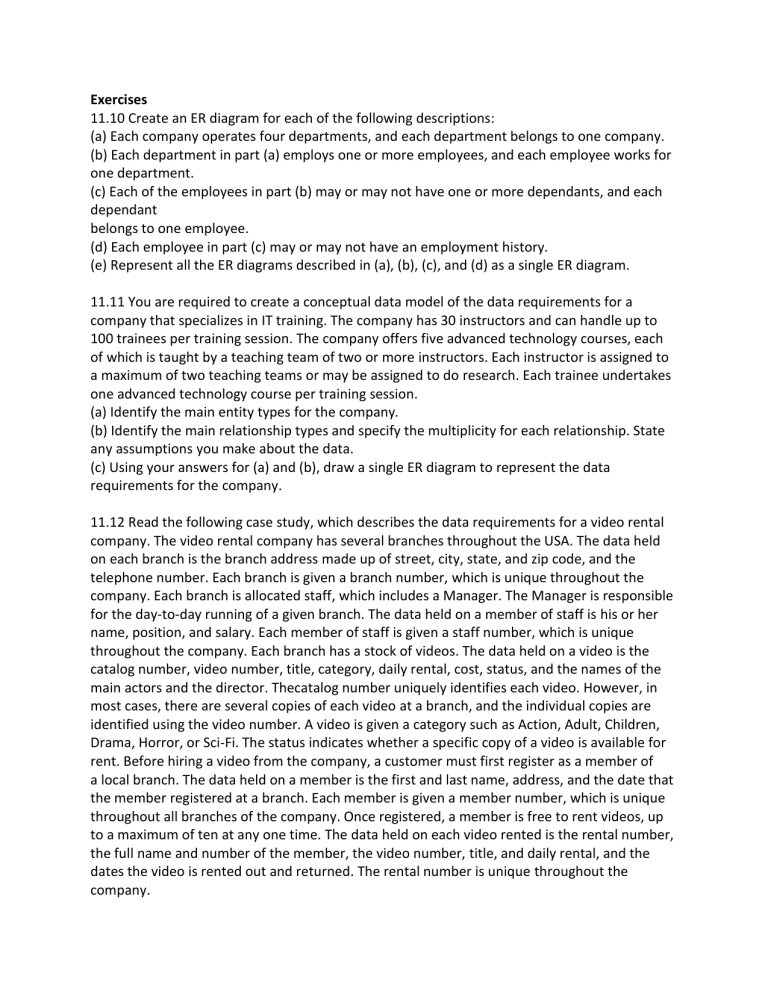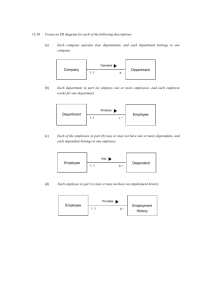12.10 Create an ER diagram for each of the following descriptions

Exercises
11.10 Create an ER diagram for each of the following descriptions:
(a) Each company operates four departments, and each department belongs to one company.
(b) Each department in part (a) employs one or more employees, and each employee works for one department.
(c) Each of the employees in part (b) may or may not have one or more dependants, and each dependant belongs to one employee.
(d) Each employee in part (c) may or may not have an employment history.
(e) Represent all the ER diagrams described in (a), (b), (c), and (d) as a single ER diagram.
11.11 You are required to create a conceptual data model of the data requirements for a company that specializes in IT training. The company has 30 instructors and can handle up to
100 trainees per training session. The company offers five advanced technology courses, each of which is taught by a teaching team of two or more instructors. Each instructor is assigned to a maximum of two teaching teams or may be assigned to do research. Each trainee undertakes one advanced technology course per training session.
(a) Identify the main entity types for the company.
(b) Identify the main relationship types and specify the multiplicity for each relationship. State any assumptions you make about the data.
(c) Using your answers for (a) and (b), draw a single ER diagram to represent the data requirements for the company.
11.12 Read the following case study, which describes the data requirements for a video rental company. The video rental company has several branches throughout the USA. The data held on each branch is the branch address made up of street, city, state, and zip code, and the telephone number. Each branch is given a branch number, which is unique throughout the company. Each branch is allocated staff, which includes a Manager. The Manager is responsible for the day-to-day running of a given branch. The data held on a member of staff is his or her name, position, and salary. Each member of staff is given a staff number, which is unique throughout the company. Each branch has a stock of videos. The data held on a video is the catalog number, video number, title, category, daily rental, cost, status, and the names of the main actors and the director. Thecatalog number uniquely identifies each video. However, in most cases, there are several copies of each video at a branch, and the individual copies are identified using the video number. A video is given a category such as Action, Adult, Children,
Drama, Horror, or Sci-Fi. The status indicates whether a specific copy of a video is available for rent. Before hiring a video from the company, a customer must first register as a member of a local branch. The data held on a member is the first and last name, address, and the date that the member registered at a branch. Each member is given a member number, which is unique throughout all branches of the company. Once registered, a member is free to rent videos, up to a maximum of ten at any one time. The data held on each video rented is the rental number, the full name and number of the member, the video number, title, and daily rental, and the dates the video is rented out and returned. The rental number is unique throughout the company.
(a) Identify the main entity types of the video rental company.
(b) Identify the main relationship types between the entity types described in (a) and represent each relationship as an ER diagram.
(c) Determine the multiplicity constraints for each relationships described in (b). Represent the multiplicity for each relationship in the ER diagrams created in (b).
(d) Identify attributes and associate them with entity or relationship types. Represent each attribute in the ER diagrams created in (c).
(e) Determine candidate and primary key attributes for each (strong) entity type.
(f ) Using your answers (a) to (e) attempt to represent the data requirements of the video rental company as a single ER diagram. State any assumptions necessary to support your design.
Exercises
12.10 Create an ER diagram for each of the following descriptions:
(a) Each company operates four departments, and each department belongs to one company.
Company
1..1
Operates
4
Department
(b) Each department in part (a) employs one or more employees, and each employee works for one department.
Department
1..1
Employs
1..*
Employee
(c) Each of the employees in part (b) may or may not have one or more dependants, and each dependant belongs to one employee.
Employee
1..1
Has
0..*
Dependent
(d) Each employee in part (c) may or may not have an employment history.
Employee
1..1
Provides
0..*
Employment
History
(e) Represent all the ER diagrams described in (a), (b), (c), and (d) as a single ER diagram.
Company
1..1
Operates
4
Department
1..1
Employs
Employment
History
0..*
Provides
1..1
1..*
Employee
1..1
Has
0..*
Dependent
12.11 You are required to create a conceptual data model of the data requirements for a company that specializes in IT training. The Company has 30 instructors and can handle up to 100 trainees per training session. The Company offers five advanced technology courses, each of which is taught by a teaching team of two or more instructors. Each instructor is assigned to a maximum of two teaching teams or may be assigned to do research. Each trainee undertakes one advanced technology course per training session.
(a) Identify the main entity types for the company.
(b) Identify the main relationship types and specify the multiplicity for each relationship.
State any assumptions you make about the data.
(c)
Research
Using your answers for (a) and (b), draw a single ER diagram to represent the data requirements for the company.
0..*
Assigned
1..1
Instructor
1..1
IsPartOf
0..2 TeachingTea
1..1 m
Teaches
1..*
1..*
Attends
1..* 1..*
Provides
1..1
Trainee Training
Session
Advanced
Course
12.12 Read the following case study, which describes the data requirements for a video rental company. The video rental company has several branches throughout the USA. The data held on each branch is the branch address made up of street, city, state, and zip code, and the telephone number. Each branch is given a branch number, which is unique throughout the company. Each branch is allocated staff, which includes a Manager. The Manager is responsible for the day-today running of a given branch. The data held on a member of staff is his or her name, position, and salary. Each member of staff is given a staff number, which is unique throughout the company. Each branch has a stock of videos. The data held on a video is the catalog number, video number, title, category, daily rental, cost, status, and the names of the main actors, and the director. The catalog number uniquely identifies each video. However, in most cases, there are several copies of each video at a branch, and the individual copies are identified using the video number. A video is given a category such as Action, Adult, Children, Drama, Horror, or Sci-
Fi. The status indicates whether a specific copy of a video is available for rent. Before hiring a video from the company, a customer must first register as a member of a local branch. The data held on a member is the first and last name, address, and the date that the member registered at a branch. Each member is given a member number, which is unique throughout all branches of the company. Once registered, a member is free to rent videos, up to maximum of ten at any one time. The data held on each video rented is the rental number, the full name and number of the member, the video number, title, and daily rental, and the dates the video is rented out and date returned. The rental number is unique throughout the company.
(a) Identify the main entity types of the video rental company.
(b) Identify the main relationship types between the entity types described in (a) and represent each relationship as an ER diagram.
(c) Determine the multiplicity constraints for each relationship described in (b). Represent the multiplicity for each relationship in the ER diagrams created in (b).
(d) Identify attributes and associate them with entity or relationship types. Represent each attribute in the ER diagrams created in (c).
(e) Determine candidate and primary key attributes for each (strong) entity type.
(f) Using your answers (a) to (e) attempt to represent the data requirements of the video rental company as a single ER diagram. State any assumptions necessary to support your design.
Video
Is
1..*
VideoForRent
1..*
IsPartOf
IsAllocated
1..1
Branch
Registers
1..1
0..1
Has
1..*
Manages
1..1
Staff staffNo
0..*
RentalAgreement
0..* rentalNo
Requests
1..*
1..*
1..1
Registration
Agrees
1..*
1..1
Member memberNo
12.13 Create an ER model for each of the following descriptions:
(a) A large organization has several parking lots, which are used by staff.
(b) Each parking lot has a unique name, location, capacity, and number of floors (where appropriate).
(c) Each parking lot has parking spaces, which are uniquely identified using a space number.
(d) Members of staff can request the use of a parking space. Each member of staff has a unique number, name, telephone extension number, and vehicle license number.
(e) Represent all the ER models described in parts (a), (b), (c), and (d) as a single ER model.
Provide any assumptions necessary to support your model.
Problem 1
We would like to design a database to maintain information about hospital staff, including doctors and nurses, and patients at the hospital. The information we need includes:
Staff, including their names, addresses and social-security numbers.
Patients, including their names, addresses, and the name of their insurance company.
Patients are each assigned to a ward (room).
Those staff who are nurses are assigned to zero or more wards. Each ward has at least one nurse assigned.
Those staff who are doctors are assigned to zero or more patients. Patients may or may not have a doctor assigned, and they may have more than one doctor.
Patients in the same ward may have different doctors but will always have the same nurse(s).
Note that there is no single right answer to this question, although some answers may be better than others.
Problem 2
Draw an ER diagram that models the information in the following scenario: A manufacturing company has several assembly plants in different cities. Each plant produces one product which requires certain parts in its assembly. The parts are from appropriate suppliers, located in different cities. Obtained in bulk amounts, certain parts may be used in more than one product.
Problem 3
Imagine you work for the public housing agency of a city, and you have been charged with keeping track of who is living in the agency's developments over time. To help you in this task, you have decided to use a relational database for your record keeping.
Your task is to design a database that allows you to capture the facts described below:
The city has three public housing developments. You want to record their names, locations, the year they opened, and their height in stories.
For each unit in the development, you want to keep track of the number of bedrooms, the number of bathrooms, whether the unit has a kitchen or living room, and the square footage.
The database should keep track of the households living in the units. For each member of a household, you want to record their name, date of birth, sex, and indicate whether or not they are they are the head of the household (more than one person can share that distinction).
You also want to keep track of when a household moved into and out of a particular unit. You want to be able to follow households as they move from one unit to another or from one development to another. Think about how you will find the unit that the household is currently occupying (i.e., what query would you write to find the current unit of each household).
You will invent data for the three developments; two units in each development; and three families, one with 2 members, one with 3 members, and one with 4 members.
Include records for each household making one move to another unit.
You may be interested to know that this assignment was inspired by records kept by the Boston Housing Authority about their developments. Hence, this type of problem has definite real-world importance.
Problem 4
In this problem, we shall design a database involving cities, the countries they are in, and "consulates." The relevant information:
Each city is in a unique country. Data about cities include the name of the city and its population. Names of cities are unique within countries, but two cities in different countries may have the same name (and possibly even the same population).
Information about a country includes its name and its head of state. You may
assume no two countries have the same name.
Information about a consulate includes its name, which is unique (e.g.,
"consulate of the United States in Toronto") and its street address (which is unique within a city, but might not be unique among all consulates in different cities).
Cities and the country they are in are related by a relationship In .
Consulates and the city in which each is located are related by a relationship Location .
Countries and consulates are related by a representation Represents . Each country represented by a consulate has a consul, who is represented only by a name. A subtle point is that occasionally, a consulate will represent more that one country. For example, country A may not have diplomatic relations with country B, so A will ask country C to represent A's interests in country B at their own consultates. In that case, the consul for country A is actually a citizen of country C, and that person will likely not be the same as the consul for country C at the same consulate.
While you might assume that a country would have at most one consulate in a given city, that is not always the case. For example, the US retains two consulates in Jerusalem.
Problem 5
Design an ER diagram for keeping track of information about votes taken in the U.S.
House of Representatives during the current two-year congressional session.
The database needs to keep track of each U.S. STATE’s Name (e.g., Texas,
New York, California) and includes the Region of the state (whose domain is
{Northeast, Midwest, Southeast, Southwest, West}).
Each CONGRESSPERSON in the House of Representatives is described by their Name, and includes the District represented, the StartDate when they were first elected, and the political Party they belong to (whose domain is
{Republican Democrat, Independent, Other}).
The database keeps track of each BILL (i.e., proposed law), and includes the
BillName, the DateOfVote on the bill, whether the bill PassedOrFailed (whose
domain is {YES,NO}), and the Sponsor (the congressperson(s) who sponsored-
-i.e., proposed--the bill).
The database keeps track how each congressperson voted on each bill (domain of vote attribute is {Yes, No, Abstain, Absent}).
Draw an ER diagram for the above application. State clearly any assumptions you make.





